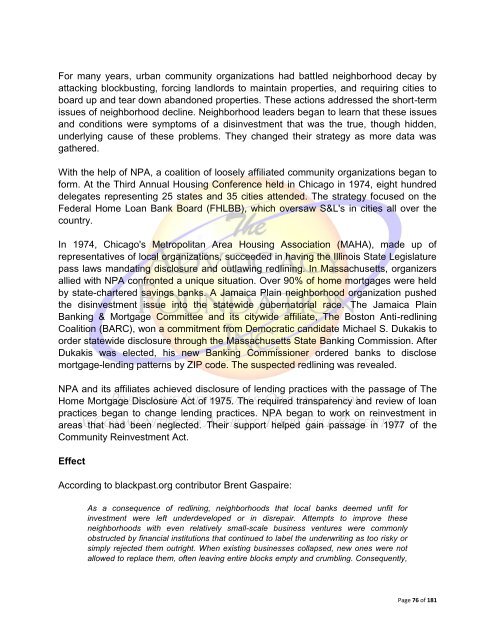You also want an ePaper? Increase the reach of your titles
YUMPU automatically turns print PDFs into web optimized ePapers that Google loves.
For many years, urban community organizations had battled neighborhood decay by<br />
attacking blockbusting, forcing landlords to maintain properties, and requiring cities to<br />
board up and tear down abandoned properties. These actions addressed the short-term<br />
issues of neighborhood decline. Neighborhood leaders began to learn that these issues<br />
and conditions were symptoms of a disinvestment that was the true, though hidden,<br />
underlying cause of these problems. They changed their strategy as more data was<br />
gathered.<br />
With the help of NPA, a coalition of loosely affiliated community organizations began to<br />
form. At the Third Annual Housing Conference held in Chicago in 1974, eight hundred<br />
delegates representing 25 states and 35 cities attended. The strategy focused on the<br />
Federal Home Loan Bank Board (FHLBB), which oversaw S&L's in cities all over the<br />
country.<br />
In 1974, Chicago's Metropolitan Area Housing Association (MAHA), made up of<br />
representatives of local organizations, succeeded in having the Illinois State Legislature<br />
pass laws mandating disclosure and outlawing redlining. In Massachusetts, organizers<br />
allied with NPA confronted a unique situation. Over 90% of home mortgages were held<br />
by state-chartered savings banks. A Jamaica Plain neighborhood organization pushed<br />
the disinvestment issue into the statewide gubernatorial race. The Jamaica Plain<br />
Banking & Mortgage Committee and its citywide affiliate, The Boston Anti-redlining<br />
Coalition (BARC), won a commitment from Democratic candidate Michael S. Dukakis to<br />
order statewide disclosure through the Massachusetts State Banking Commission. After<br />
Dukakis was elected, his new Banking Commissioner ordered banks to disclose<br />
mortgage-lending patterns by ZIP code. The suspected redlining was revealed.<br />
NPA and its affiliates achieved disclosure of lending practices with the passage of The<br />
Home Mortgage Disclosure Act of 1975. The required transparency and review of loan<br />
practices began to change lending practices. NPA began to work on reinvestment in<br />
areas that had been neglected. Their support helped gain passage in 1977 of the<br />
Community Reinvestment Act.<br />
Effect<br />
According to blackpast.org contributor Brent Gaspaire:<br />
As a consequence of redlining, neighborhoods that local banks deemed unfit for<br />
investment were left underdeveloped or in disrepair. Attempts to improve these<br />
neighborhoods with even relatively small-scale business ventures were commonly<br />
obstructed by financial institutions that continued to label the underwriting as too risky or<br />
simply rejected them outright. When existing businesses collapsed, new ones were not<br />
allowed to replace them, often leaving entire blocks empty and crumbling. Consequently,<br />
Page 76 of 181

















